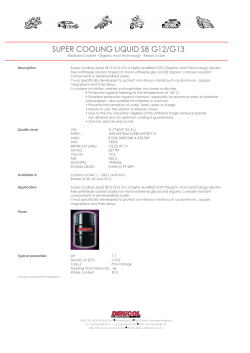
Bioelectronics Symposium Nanyang Technological University, October 20-21, 2014
Bioelectronics Symposium Nanyang Technological University, October 20-21, 2014 Venue: Nanyang Executive Center (NEC) Education Wing Lecture Room 2, Level 2 Sponsored by Bioelectronics Symposium Nanyang Technological University, Venue: Nanyang Executive Center (NEC) Education Wing Lecture Room 2, Level 2 Scientific Programme for the Bioelectronics Symposium Nanyang Executive Center (NEC), Education Wing Lecture Room 2, level 2 Sunday Oct. 19 18.00 Activity Dinner for invited speakers (meet in Lobby Nanyang Executive Center, NEC) Monday, Oct 20 17.00 Speaker: Title Chairman: Bo Liedberg Welcome address Wolfgang Knoll Zhenan Bao, Stanford University, USA Skin Inspired Electronics Based on Organic Materials Chen Xiaodong, NTU, Singapore Nanoelectronic Memory Devices Based on Silk Protein Coffee/Tea break Chairman: Chen Peng Tai Hyun Park, National Seoul University, Korea Bioelectronic Nose: Integration of Human Olfactory Receptors and Nano Devices Ciril Reiner-Rozman, AIT, Vienna, Austria Construction and Optimization of a Graphene-Based Field Effect Transistor Device Lunch Chairman: Sven Ingebrandt Thakor Nitish V, SYNAPS, NUS, Singapore Neurotechnology: Building Implantable Brain Machine Interfaces Kim “Ritchie” Dongwhan Plasmonic Nanosensor: Synthesis, Assembly and Signal Amplification Stefano Lai, University of Cagliari, Italy Organic Charge Sensing Devices as Powerful Tools for the Quantitative Detection of Biological, Chemical, and Physical Variables Coffee/Tea break Chairman: Bo Liedberg Fabio Biscarini, Università di Modena e Reggio Emilia, Italy Organic Bioelectronics for Regenerative Medicine Chen Peng, SCBE, NTU, Singapore Nanoelectronic Detection of Dynamic Cell Functions Sven Ingebrandt, University of Kaiserslautern, Germany Micro- and nanoscale sensor arrays for biomedical applications End day 1 18.30 Dinner for invited speakers 9.00 9.15 9.50 10.25 10.50 11.25 12.00 13.00 13.35 14.10 14.45 15.15 15.50 16.25 Tuesday, Oct 21 11.55 12.15 Speaker: Title Chairman: Wolfgang Knoll Magnus Berggren, Linköping University, Sweden Organic Bioelectronic Devices and Circuits to Regulate Cell Signaling – Towards New Therapy Methods Alfred Tok, MSE, NTU, Singapore Novel Graphene Biosensors for IL-6 Detection Coffee/Tea break Chairman: Bo Liedberg Wolfgang Knoll, AIT, Vienna, Austria Smell Sensors – Optical or by Electronics? Donata Iandolo, Linköping University, Sweden PEDOT:tosylate coated macroporous scaffolds via vapor phase polymerization for osteoinduction studies Summary Wolfgang Knoll Lunch for invited speakers 13.00 Labtour 15.00 End of day 2 and Symposium 9.00 9.35 10.15 10.35 11.20 Contact details: Wolfgang Knoll (organizer) Email : Wolfgang.Knoll@ait.ac.at +43 50550 4002 Bo Liedberg (organizer) Email : bliedberg@ntu.edu.sg Tel : +65 90182416 Phyllis Lim (Symposium secretary) Email : phyllislim@ntu.edu.sg Tel : +65 94590093 Nanyang Executive Centre (NEC) Symposium venue http://www.ntu.edu.sg/NEC Email : ntu-NEC@ntu.edu.sg Tel : 6790 6699 Simon Lim (Driver) Email: simonlimtransport@gmail.com Tel : +65 9795 7573 +65 9877 4166 Skin Inspired Electronics Based on Organic Materials Zhenan Bao Chemical Engineering, and Chemistry, Materials Science and Engineering Stanford University, 381 North South Axis, Stanford CA 94305-5025 E-mail: zbao@stanford.edu Organic and carbon nano materials are attractive for low cost electronic units for electronic skin as well as medicinal, food storage, and environmental monitoring applications. The ability to couple the sensory electrical output with on-chip signal processing can overcome the need for bulky, expensive equipment typically required for most optical detection methods. In this talk, I will present recent progress in materials design to enhance charge transport properties and to enable high performance large area solution coated flexible and stretchable transistors and sensors. Finally, the applications of these materials and devices for skin-inspired sensors, electronics and battery devices will be presented. Nanoelectronic Memory Devices Based on Silk Protein Xiaodong Chen School of Materials Science and Engineering Nanyang Technological University, 50 Nanyang Avenue, Singapore, 639798 Email: chenxd@ntu.edu.sg Memory nanodevices have attracted intensive attention owing to their potential applications in nanoelectronic memories, computer logic, neuromorphic computer architectures, and so on. Various materials such as metal oxides, chalcogenides, amorphous silicon, carbon, and polymer-nanoparticle composite materials exhibit memory phenomena. We have demonstrated that show that natural biomaterials like proteins can be used for the fabrication of solid-state memory devices. In this talk, I will show how sericin, one kind of silk protein, can be used to fabricate nonvolatile memory device for the first time. Excellent memory characteristics with resistance OFF/ON ratio larger than 106 have been obtained and multi-level memory based on sericin has been achieved. The environmentally friendly high performance biomaterials based memory devices may hold a place in the future of electronic device development. Bioelectronic Nose: Integration of Human Olfactory Receptors and Nano Devices Tai Hyun Park School of Chemical and Biological Engineering, Seoul National University, Seoul 151-744, Republic of Korea E-mail: thpark@snu.ac.kr The olfactory system plays an important role in recognizing environmental conditions. Since olfactory receptor genes were identified and cloned, various researches on olfactory systems have been carried out, and the interest in olfaction research has been increasing due to its potential industrial applications. In the smelling process, the binding of specific odorants to the olfactory receptor proteins is the initiation step in odor recognition and triggers signal transduction in a cell. Functional expression of the olfactory receptors on the surface of culturable cells is very useful for application to an olfactory and sensor. “Bioelectronic nose” consists of primary and secondary transducers. The primary transducer is a biological sensing element that is human olfactory receptor, and the secondary transducer is a nanotube. The bioelectronic nose has sensitivity and selectivity comparable to the natural human nose. Moreover, it demonstrates specificity characteristics similar to those in the cellular signal transduction pathway and displays antagonistic behavior similar to the natural human nose. This bioelectronic nose can be used in industrial applications as an extremely specific and sensitive sensor as well as in scientific applications for studying the mechanism of olfaction and the interaction between olfactory receptors and odorant molecules. It can be used for standardization of smell, smell industry, medical diagnosis, food quality assessment, environment monitoring, process monitoring, public safety and so on. Construction and Optimization of a Graphene-Based Field Effect Transistor Device Ciril Reiner-Rozman1,2, Melanie Larisika1, Christoph Nowak1,2, Christoph Kleber2, Wolfgang Knoll1,2,3 1 AIT Austrian Institute of Technology, Vienna, Austria, 2 Centre for electrochemical surface technology, Wiener Neustadt, Austria 3 Center for Biomimetic Sensor Science, Nanyang Technological University, Singapore Email: Rozman.Ciril.fl@ait.ac.at We present the construction and characterization of reduced Graphene-Oxide (rGO) based FETs and their use for biosensing applications. Devices were fabricated using wet-chemically synthesized graphene, displaying high electron and hole mobility (µ), thus offering a very high sensitivity also for low potential changes. The device performance was tested in the liquid gate mode of operation with variation of the ionic strength and the pH-values of the electrolytes in contact with the gate in a flow cell and for the sensing of biomolecules. A model based on a modified metal oxide semiconducting field effect transistor (MOSFET) theory for the devices presented in this work allows for the calculation of the channel current and its dependence on interfacial parameters. The interplay of the electrolyte liquid with graphene in the semiconductor-channel determines the devices conductivity, represents simultaneously the carrier medium and the contact layer and enables a real-time read out for different applications. Examples discussed concern the binding of bovine serum albumin (BSA) as reference and aflatoxin B1 in real life food samples after testing several passivation agents against unspecific binding of corn extracts. Neurotechnology: Building Implantable Brain Machine Interfaces Nitish V. Thakor Provost Chair Professor National University of Singapore Director, Singapore Institute for Neurotechnology (SiNAPSE) Email: sinapsedirector@gmail.com; Web: www.sinapseinstitute.org; Brain machine interfaces have evoked interest as therapeutic devices for treating neurological disorders - from brain to periphery. Such technology may be useful in treating disorders such as epilepsy and Parkinson's, spinal cord injury and paralysis, and helping provide therapeutic solutions for controlling prosthetic limbs and nerve injuries leading to loss of limb function. A common theme for the neurotechnology needed is that it must be implanted for a chronic, autonomous function. In order to build an implantable brain machine interface, the common framework involves bioelectronic interfaces in the form of electrodes and electronics. This talk will review implantable electrode technologies, low power electronics and wireless circuits, and proposed implanted systems for neural prosthesis brain machine interfaces. Plasmonic Nanosensor: Synthesis, Assembly and Signal Amplification Donghwan KIM, Richie School of Chemical and Biomedical Engineering, Nanyang Technological University, 70 Nanyang Drive, Singapore 637457 Email: DHKIM@ntu.edu.sg Based on the localized surface plasmon resonance (LSPR) of metallic nanoparticles, plasmonic nanosensors have emerged as a powerful tool for biosensing applications. To date, many detection schemes have been developed and the field is rapidly growing to incorporate new methodologies and applications. Amidst all of the ongoing research efforts, one common factor remains a key driving force: continued improvement of high-sensitivity detection. Recognizing the importance of this subject, yet there has been limited attention to strategies for improving the sensitivity of plasmonic nanosensors, this talk will highlight our recent progress on different strategies used for improving the sensitivity of plasmonic nanosensors. Particular, this talk will cover following two categories based on sensing mechanisms: 1) sensing based on cluster of plasmonic nanoparticles, 2) sensing based on single nanoparticles. The basic principles and newly developed examples will be provided for each kind of strategy, collectively forming a unifying framework to view the latest attempts to improve the sensitivity of nanoplasmonic sensors. Recent attempt for field application of these devices will be also discussed. Organic Charge Sensing Devices as Powerful Tools for the Quantitative Detection of Biological, Chemical, and Physical Variables Stefano Lai1, Piero Cosseddu1, Andrea Spanu1, Massimo Barbaro1, Mariateresa Tedesco2, Sergio Martinoia2, Annalisa Bonfiglio1,3 1 Department of Electrical and Electronic Engineering, University of Cagliari, Piazza d’Armi, 09123 Cagliari, Italy, 2 Department of Informatics, Bioengineering, Robotics and System Engineering, University of Genova, Via Opera Pia, 13 - 16145 Genova, Italy, 3 CNR – Institute of Nanoscience, S3 Centre, Via Campi 213A, 41125, Modena, Italy Email: stefano.lai@diee.unica.it, annalisa@diee.unica.it Electronic readout of chemical, biological and physical variables has attracted arising interest in the last decades as a suitable alternative to classical analytical techniques. In particular, field-effect transistor-based sensors and interfaces have been widely studied for detecting and transducing several kinds of events related to a variation of the charge and/or charge distribution. So far, several examples have been proposed and different technologies have been employed; recently, several examples of FET-based sensors based on the technology of organic semiconductors, have been proposed. Organic electronics allows the replication of devices and systems on very large areas with relatively low costs, and this possibility suggests, quite naturally, the fabrication of disposable sensors, for biological, chemical and physical variables, on plastic substrates. However, only few examples of OFET-based biosensor and biointerfaces actually applied in operational environment have been so far reported. The reasons behind the limited diffusion of this technology can be found in technological and transduction drawbacks, whose solution is attracting the attention of the scientific community and is not trivial. The quantitative sensing of biological, chemical, and physical parameters is even more challenging for organic devices as it requires tools with characteristics that are sometimes in contrast with the commonly intended limits of organic electronics as sensitivity to harsh environment, relatively slow responses, etc. In this talk, we will discuss an innovative approach for charge sensing with organic devices which is particularly designed for overcoming the main technological and operational limitation of FET-based biosensors and interfaces. In particular it will be shown how a unique working principle, that can be implemented with different technological processes, can be tailored for different application fields by playing with the device architecture. As a result of a precise control of the device design and integration with biochemical and physical elements, it will be demonstrated that the operational stability, sensitivity, response rapidity necessary to get optimal performances in many applications can be obtained. Several kinds of biological, chemical, physical sensors and a novel FET-based interface for monitoring the activity of electrically-excitable cells will be finally presented and discussed. Organic Bioelectronics for Regenerative Medicine Fabio Biscarini Life Science Dept., Università di Modena e Reggio Emilia Via Campi 183, 41125 Modena, Italy Email: fabio.biscarini@unimore.it Electronic transducers of neuronal cellular activity are important devices in neuroscience and neurology. Organic field-effect transistors (OFETs) offer tailored surface chemistry, mechanical flexibility, and high sensitivity to electrostatic potential changes at device interfaces. These properties make them attractive for interfacing electronics to neural cells and performing extracellular recordings and stimulation of neuronal network activity. Here I want to present an emerging area of interest where the OFET is used as a gauge to supply a variety of electrical, chemical and electrochemical stimuli to neuronal cells, in an effort to stimulate their plasticity else to differentiate neuronal stem cells into neurons. I will overview the progresses of an ongoing EU project, “Implantable Organic Nanoelectronics” (I-ONE-FP7) which is aimed to the use of organic electronics in implantable devices for the treatment of the spinal cord injury (SCI). The project is presently at midterm, and I will highlight the advances to date and discuss the direction of further development towards in-vivo experiments on animal model of the SCI. This work involves collaboration of several partners, that I would like to acknowledge through the principal investigators: S. Pluchino (Univ. of Cambridge), M. Berggren and D. Simon (Univ. Linkoeping), F. Zerbetto and S. Rapino (Univ. of Bologna), P. Greco (Scriba Nanotecnologie Srl Bologna), L. Occhipinti (ST Microelectronics Catania), D. Vuillaume (CNRS, Lille), R. Garcia (CSIC Madrid), H. Gomes (Univ. do Algarve), R. Frycek (Amires Sarl, Neuchatel), E. Cerna and V. Velebny (Contipro Dolni Dobrouc), T. Cramer, S. Casalini, F. Valle (CNR-ISMN Bologna), G. Foschi, C. A. Bortolotti, N. Dorigo (UNIMORE). This work is supported by EU NMP Project I-ONE Grant Agreement n. 280772. Nanoelectronic Detection of Dynamic Cell Functions Peng Chen, School of Chemical & Biomedical Engineering Nanyang Technological University, Singapore Email: ChenPeng@ntu.edu.sg As the current follows solely or largely on the surface, the conductance of the semiconducting nanomaterials is highly sensitive to the electrochemical perturbation induced by the interacting biomolecules or by biological activities of the interacting cells. Taking advantage of this, nanoelectronic biosensors based on these nanostructured materials have been developed, promising novel applications for fundamental studies, diagnosis, and drug screening. This presentation briefly reviews our works on the nanoelectronics-biology interface. More specifically, we have developed and used nanoelectronic field-effect transistors based on carbon nanotubes, graphene, or silicon nanowires to electrically detect the presence of biomolecules or dynamic activities of live cells (secretion of biomolecules or chemicals, ion channel activities, metabolic activities), with high sensitivity, high temporal resolution, and high throughput. Micro- and nanoscale sensor arrays for biomedical applications Sven Ingebrandt Department of Computer Sciences and Microtechnology University of Applied Sciences Kaiserslautern 66482 Zweibrücken, Germany E-mail: sven.ingebrandt@fh-kl.de The biomedical signaling research group at the University of Applied Sciences Kaiserslautern, Germany, is an international, interdisciplinary group composed of Ph.D. students and Postdocs. The research subjects are related to developing and interfacing micro- and nanoscale sensors with different biosystems at length scales from µm to nm. In this framework the group is working in different governmental, industry and EU-funded projects. This talk will provide an overview over the current subjects with special emphasize to possible biomedical applications. In the past we mainly worked with silicon-based, microsized field-effect transistor arrays for in vitro recording from cell cultures or for the label-free, fully-electronic detection of biomolecules. In recent years we scaled the sensors pads of our devices down to nano-dimensions. Our working horse are top-down fabricated silicon nanowire (SiNW) transistor arrays for sensing of biomolecular surface interactions such as DNA or antigen-antibody binding and the use of these devices to record extracellular signals from cells. Those nano-scale devices show superior performance in biomedical applications compared to their micro-scale counterparts. In the current format, however, our silicon-based readout devices are far too expensive to produce and far too difficult to handle to allow for real applications in the biomedical field. In newer approaches we try to combine the electrochemical readout of our nano-scale electronic devices with optical readout detecting the signals with two – almost independent – transducer principles, simultaneously. These activities are embedded in the EU-ITN ‘Prosense’, where we aim to detect a mixture of different prostate cancer biomarkers from blood serum in one assay. There we team up with experts from the field of biosensors with optical transducer principles. For this purpose we currently produce SiNW devices on transparent substrates to combine our readout principle with classical optical sensing of biomolecules. In an outlook we will present alternative approaches using graphene-based, 2Dchalcogenide based or semiconducting polymer-based materials as integral components of the device platforms. We believe that either the top-down processed SiNW arrays combined with an industry standard like CMOS processing or very cheaply produced alternative approaches as disposable devices might have the potential to be successfully introduced to the biomedical industry. This talk will introduce several different sensor platforms and show examples of several different bioassays from detection of biomolecules, detection of cellular signals in vitro, detection of cell-substrate adhesion strength on a single cell level while comparing the approaches and commenting on the different possible applications. Organic Bioelectronic Devices and Circuits to Regulate Cell Signaling – Towards New Therapy Methods Magnus Berggren Department of Science and Technology Linköping University, Linköping, Sweden Email: magnus.berggren@liu.se Conductors, diodes and transistors based on ion-selective membranes and conjugated polymers are reported. These Organic Iontronic devices can define desired linear and non-linear device characteristics and can be combined into chemical circuits to generate highly accurate and complex biochemical signal patterns. The signal patterns are then successfully utilized and applied to regulate signaling and physiology in cells systems, in vitro and in vivo. The mechanism of operation of the fundamental devices will be described along with the performance of various chemical circuits. Chemical circuits are utilized and explored in various applications, such as in controlling growth stages of cells and protein structures and also in various therapy settings, in particular aiming at controlling neuronal signaling and in drug delivery systems. Novel Graphene Biosensors for IL-6 Detection Alfred Tok Iing Yoong School of Materials Science and Engineering, Nanyang Technological University, 50 Nanyang Avenue, Singapore, 639798 Email: MIYTok@ntu.edu.sg Interleukin-6 (IL-6) is a multi-functional cytokine with a wide range of biological activities such as regulation of the immune system and generation of acute phase reactions. Currently, ELISA and western blot is the staple for detection of IL-6, requiring substantial time, machinery, high cost and specialized manpower training. Graphene Oxide-based amperometric sensor has the advantage of cheap, simple, real-time yet sensitive. However, the coverage of mono-layered Graphene Oxide (GO) flake on SiO2 substrate was limited to ca. 90% due to rinsing and unwanted cross-linking of 3-AminoPropylTriEthoxy Silane (APTES) adhesion layer. We demonstrate that carbon can be deposited on edges of GO flakes in a CVD at the same time homogenized the surface conductance. The post-treated GO flakes are then fabricated into a liquid-gated biosensor for detection of IL-6. Smell Sensors – Optical or by Electronics? Wolfgang Knoll AIT Austrian Institute of Technology, Vienna, Austria and Centre for Biomimetic Sensor Science, Nanyang Technological University, Singapore Email: wknoll@ntu.edu.sg For the sensing of light, e.g., in optical communication, we have extremely powerful devices with the ability to detect even single photons. Similarly, the monitoring of sound in acoustic communication is technically no problem: microphones are available with amazing performance parameters. Only for chemical communication, for smell or taste detection on a technical level we have (nearly) nothing. Despite the fact that the monitoring of chemicals in chemotaxis, i.e., the chemicals-guided search for food of many organisms or the exchange of molecules between species as a way to communicate with each other, is the oldest of our sensory repertoire, we have essentially no technical device that offers the sensitivity and the bandwidth needed to sense and to differentiate many different odors and tastes. Earlier attempts to fill this gap by “artificial noses” failed (with the only notable exception being the “alcohol breath analyser” used by police) mostly because of lack of sufficient sensitivity. In order to develop and present during this talk concepts for smell sensors that could overcome these sensitivity limits we will firstly very briefly refer to the world of smells and give a brief introduction into how mammalians and insects smell. Using a biomimetic approach, i.e., using functional elements (proteins) from nature and combining them with synthetic (nano- and micro-) devices for hybrid transducers, we then describe how (vibrational) spectroscopic approaches (IR and Raman) could help to develop sensor platforms with relevant performance parameters and refer in the end to novel schemes based on electronic (transistor) read-out concepts. PEDOT: tosylate coated macroporous scaffolds via vapor phase polymerization for osteoinduction studies Donata Iandolo*, Lim Jing¥, Swee-Hin Teoh ¥, Daniel Simon*, Magnus Berggren*, *Laboratory of Organic Electronics, Dept. of Science and Technology, Linköping University, Norrköping, Sweden. ¥ Division of Bioengineering, School of Chemical & Biomedical Engineering, Nanyang Technological University, Singapore. Email: donata.iandolo@liu.se Previous studies have clinically verified the use of polycaprolactone (PCL)-based macroporous scaffolds in bone tissue engineering applications, demonstrating their usefulness in promoting bone healing. In alternative studies conductive coating layers, used to provide electrical stimulation, were similarly shown to positively affect osteoblast cells proliferation and their long-term functions. Here we report the use of vapor phase polymerization as a straightforward technique forcoating PCL macroporous scaffolds produced via the fused deposition modelling(FDM) technique with poly(3,4-ethylenedioxythiophene):tosylate (PEDOT:tosylate). The electrochemical as well as surface and mechanical properties of the resulting conductive scaffolds have been investigated being these features pivotal for their use in osteoinduction studies. The development of these organic electronicallyfunctionalized scaffolds presents the opportunity to study the combined effects of electrical and topographical features in bone tissue engineering applications. Notes Notes Sponsored by
© Copyright 2025











